Explore this digital collection of items that were displayed at the West Point Museum's exhibit commemorating the West Point Band's 200 years of service to the Academy and the Nation.
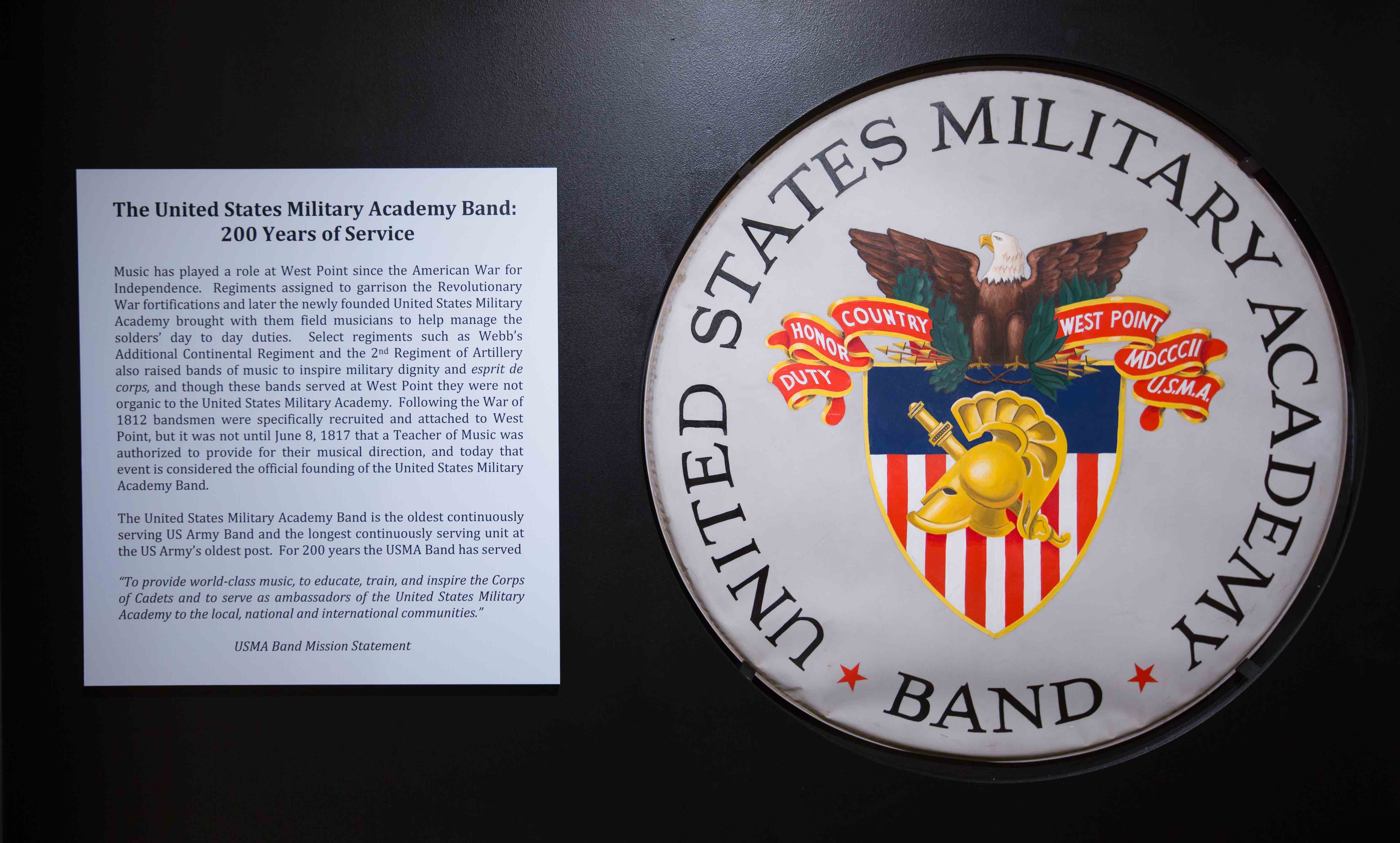
The Military Academy’s first Superintendent Colonel Jonathan Williams stated in his Superintendent’s Report of 1802 that West Point required a professional band. That need was temporarily filled by various unit bands including one made up from Captain Alden Partridge’s company of Vermont militia. In 1813 Liuetenant Colonel Joseph Swift, Chief Engineer of the Army and the second Superintendent of the United States Military Academy, ordered Colonel Alexander Macomb’s 3rd Regiment of Artillery Band to the US Army School of Music at Fort Columbus on Governor’s Island for training on new woodwind and brass instruments. In 1815 he procured band instruments and uniforms for delivery to West Point. A year later, in April 1816, Superintendent Swift ordered 11 of those retrained bandsmen to West Point to become the nucleus of a Military Academy band. Others soon followed, and by 1817 there were 14 band musicians attached to the Corps of Engineers who oversaw the United States Military Academy. All that was left to do was to hire someone to take direction of this new group.
Richard Willis was the right man at the most opportune time. Willis arrived in New York City from Ireland in 1815 and immediately put his talents to work teaching music and playing concerts. Reviewers lauded him as a virtuoso. Hearing of an opportunity to become the bandmaster at a small “school for soldiers” up the Hudson River, he applied for and entered the job in June, 1816. In an apparent need to unite instruction with supervision, the Paymaster General of the Army and the Secretary of War created the position of Teacher of Music to take direction of the band at the United States Military Academy, and on June 16, 1817 civilian hire Richard Willis was appointed to the position of Teacher of Music (TM), equivalent to the rank of Major in the United States Army.
In keeping with military tradition, the new band at the United States Military Academy required a distinctive and inspiring appearance. Even before there was a band, there was a uniform design. In 1815 Acting Superintendent Alden Partridge described a uniform based on the tradition that musicians wore uniforms of the reversed colors of the unit that they were attached to, in this case the US Army Corps of Engineers. This proposed uniform consisted of red coats trimmed in yellow with black collars and cuffs, gilt buttons, caps with red pompons tipped in white, and gaitered trousers. A musician’s sword completed the ensemble. Despite the apparent splendor of this uniform Superintendent Sylvanus Thayer in a letter to Lt. Colonel Swift dated April 30, 1818 complained “The uniform coats now worn by the Band of Musick at West Point were issued to it about two years ago and have become unfit for wear. I have endeavored to engage the Commissary to have made for the Band new coats by offering to pay him the difference of cost between those and ordinary musicians’ coats…..it is deemed necessary, in order to maintain the pride of the Band, to give them a different uniform from that of the fifers and drummers.” In 1822, Major Thayer’s wish came to fruition.
Throughout most of the 19th century the United States Military Academy Band was permitted to wear a distinctive uniform but that would change as US Army uniform regulations became more codified at the turn of the 20th century. Determined not to be swept up in the mix, the USMA Band found small ways to maintain its unique identity. In 1948 the letters “MA” (Military Academy) were added to the standard US Army uniform insignia for musicians and in 1985 the piping on the shoulder straps was changed from white to red as an homage to their Corps of Engineers roots. At that same time, the metal insignia, belt plates and buttons were changed from yellow to white metal, and in 1990 the shako pompom was changed from white to black as worn by the Corps of Cadets.
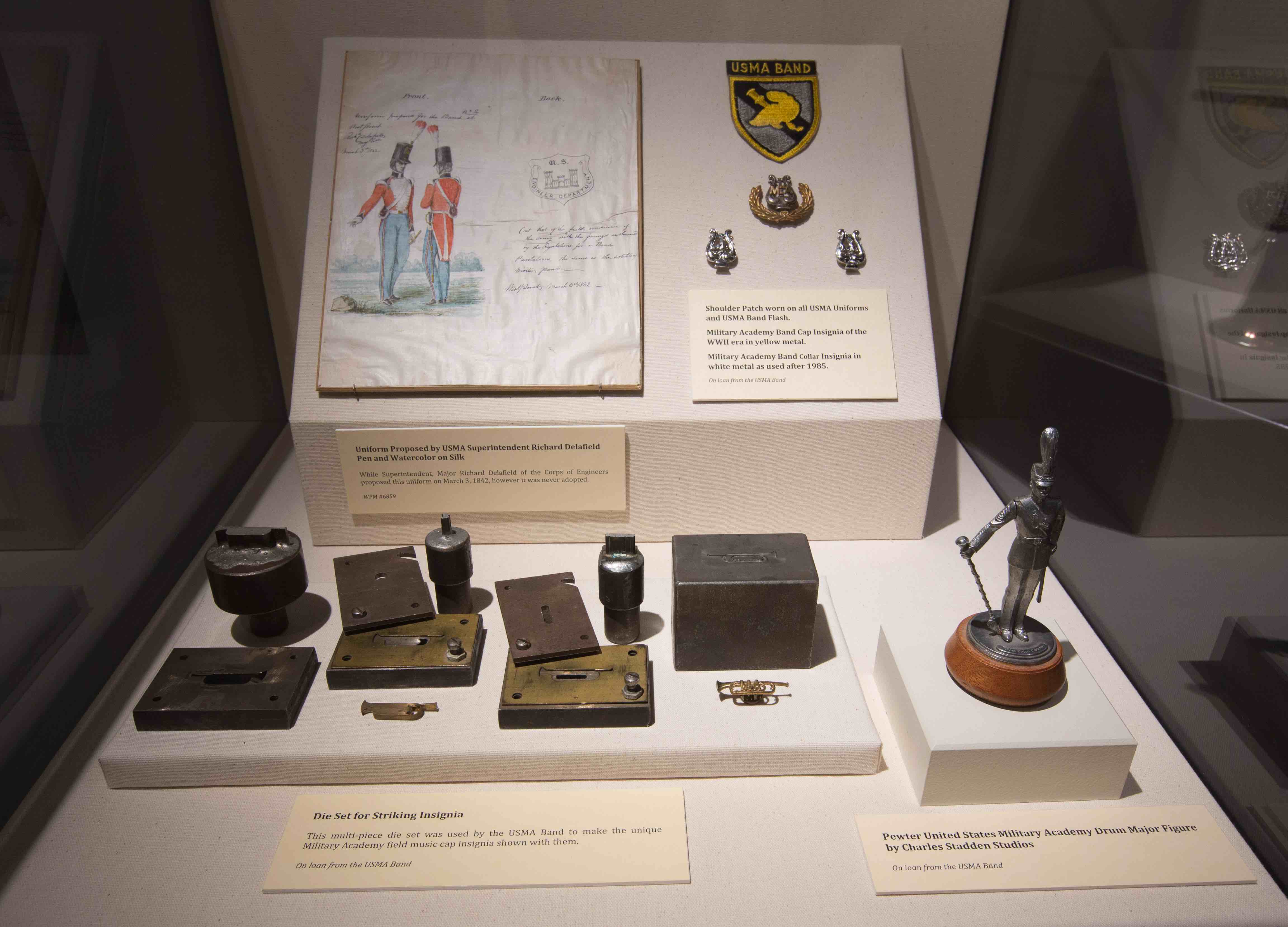
This multi-piece die set was used by the USMA
Band to make the unique Military Academy field music cap insignia shown with
them.
On loan
from the USMA Band
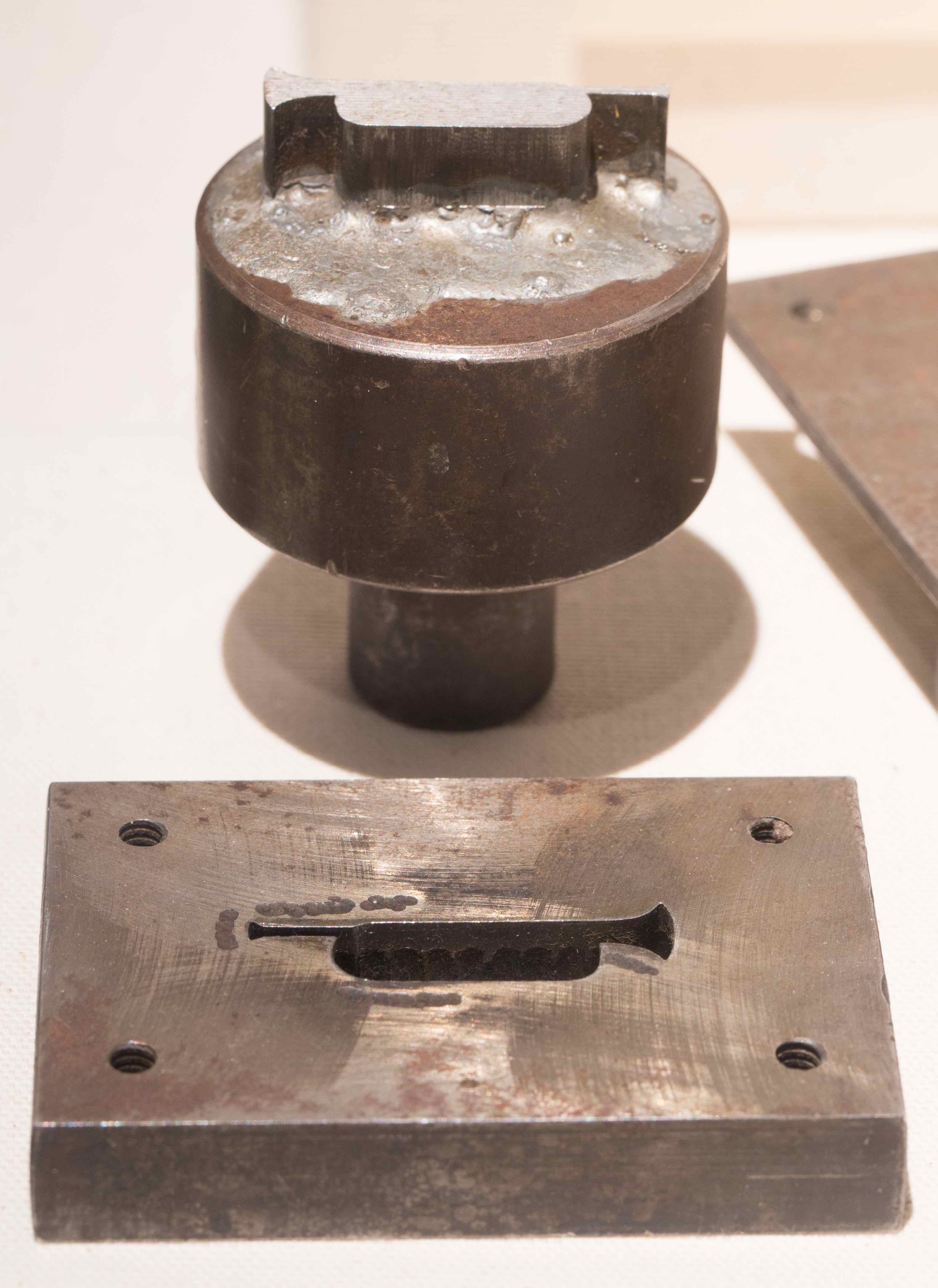
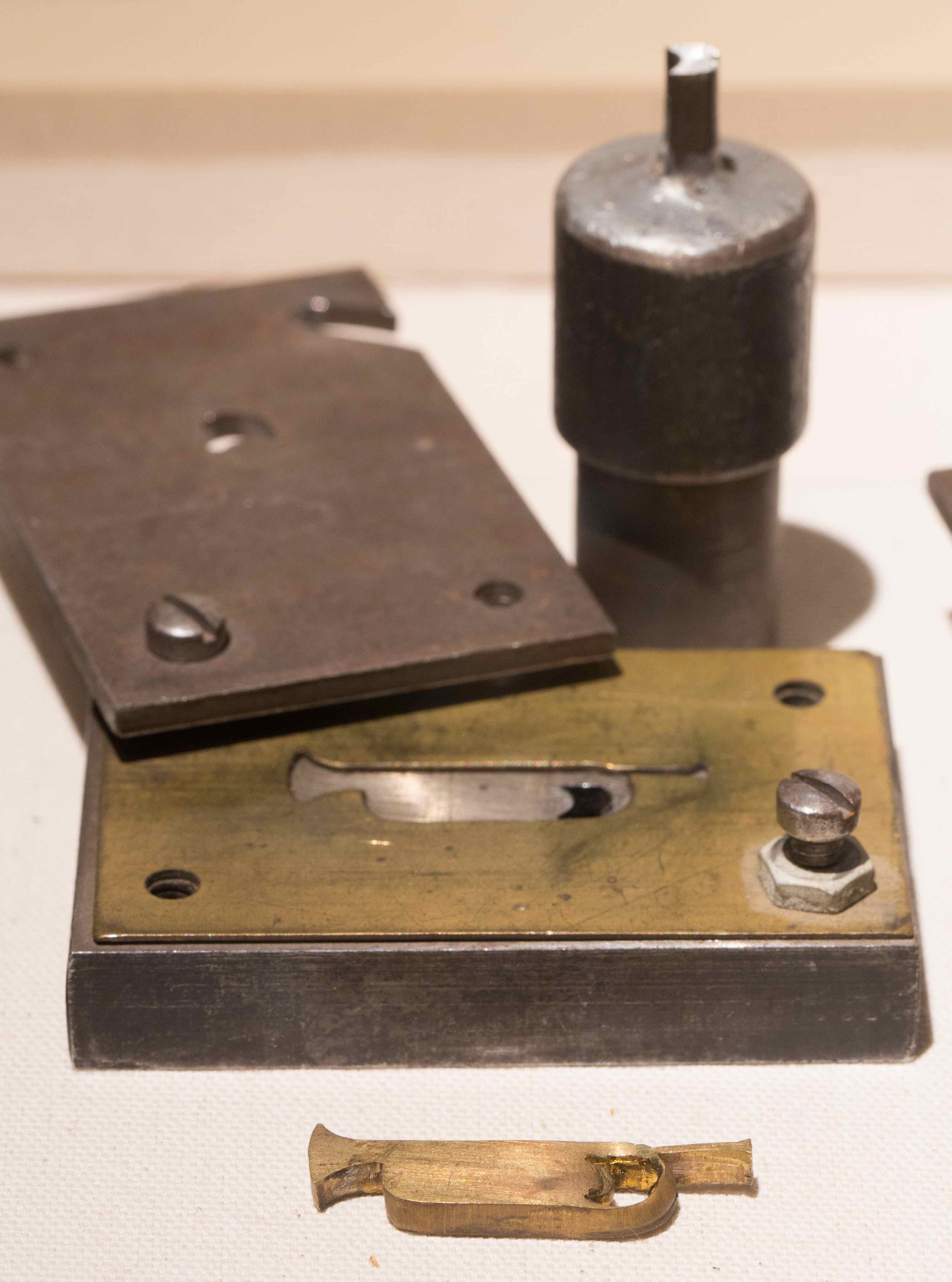
From the onset the band was referred to by many names, all of which described the band’s association in general terms: “the band attached to the Corps of Engineers”, “the band of the Military Academy at West Point”, “the military band at West Point” and in Thayer’s words “the Military Band…having been enlisted for the service of the Academy...” Whatever the name, it was clear that the band owed its existence directly to the Military Academy, and in October 1866 the name “The United States Military Academy Band” appears in official use.
The USMA Band consists of four groups: the Concert Band, the Benny Havens Band (formerly the Jazz Knights), the Hellcats, and a support staff. The Concert Band performs symphonic programs in support of the Academy’s cultural activities at various indoor and outdoor venues. They also function as the Marching Band when in the field. Among its earliest performances was the first Independence Day concert in 1817 when the band serenaded the Academy for most of the day from the ruins of Fort Putnam. In 1820 “water parties” began at which a barge with the band on board was towed up the Hudson River and allowed to quietly drift back to West Point as the band played, the scene accompanied by a flotilla of watercraft filled with audience members. The Benny Havens Band is a stage and dance band which fulfills social function needs of the Corps of Cadets and the West Point community. As early as 1941 impromptu combos of band members played for special functions. In 1972 the first stage band was formed and in 1981 that group was branded the Jazz Knights. The Hellcats are arguably the oldest serving musical component of the USMA Band, tracing their roots to the fifers and drummers of the Continental Army. As the duty musicians of the Academy, they assist in regulating the daily activities of the Corps of Cadets as well as play spirited pep rallies and render final respects at funerals. Lastly, the support staff provides technical services such as instrument repair, music arranging, public relations, operations, and administration.
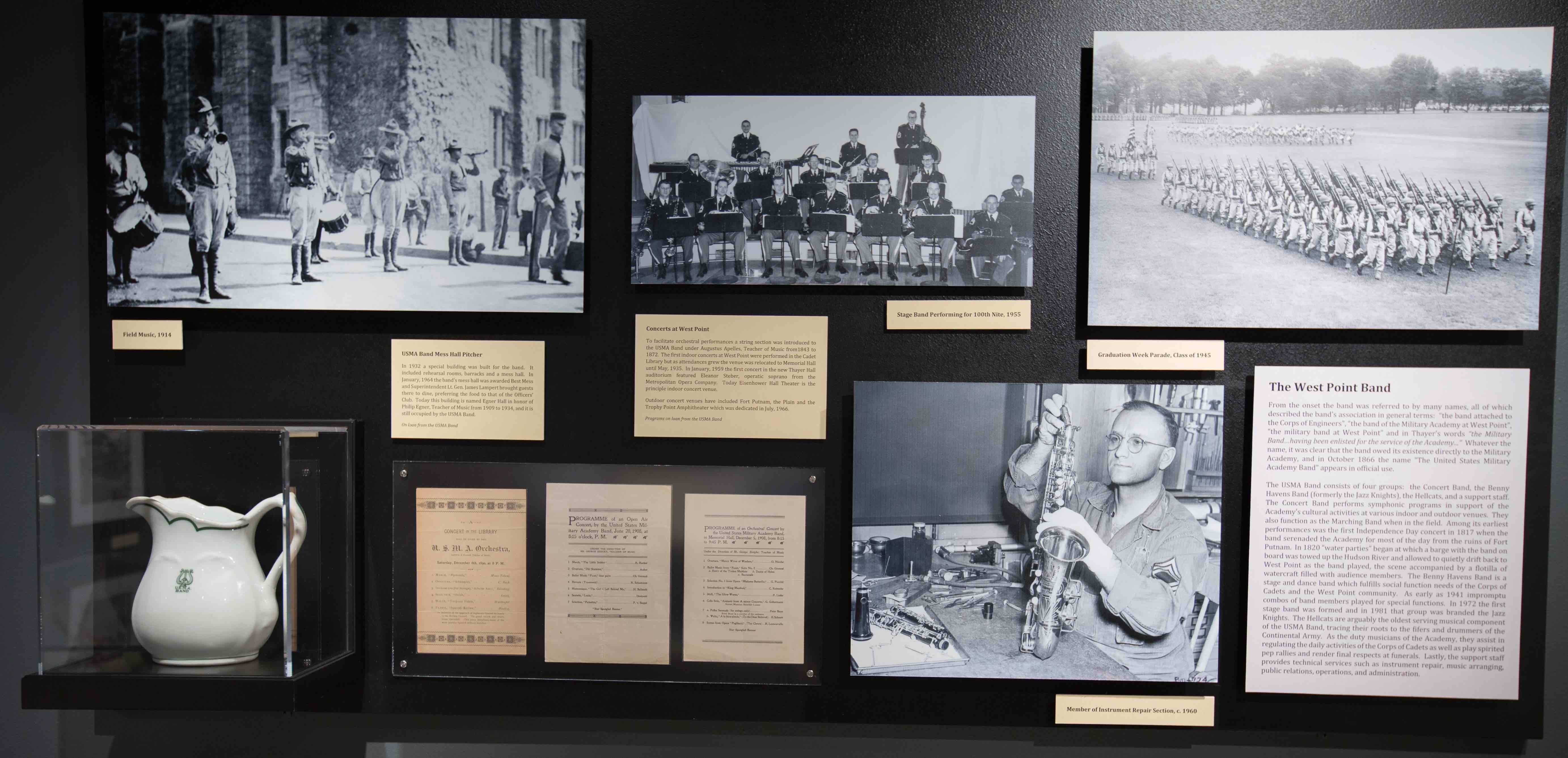
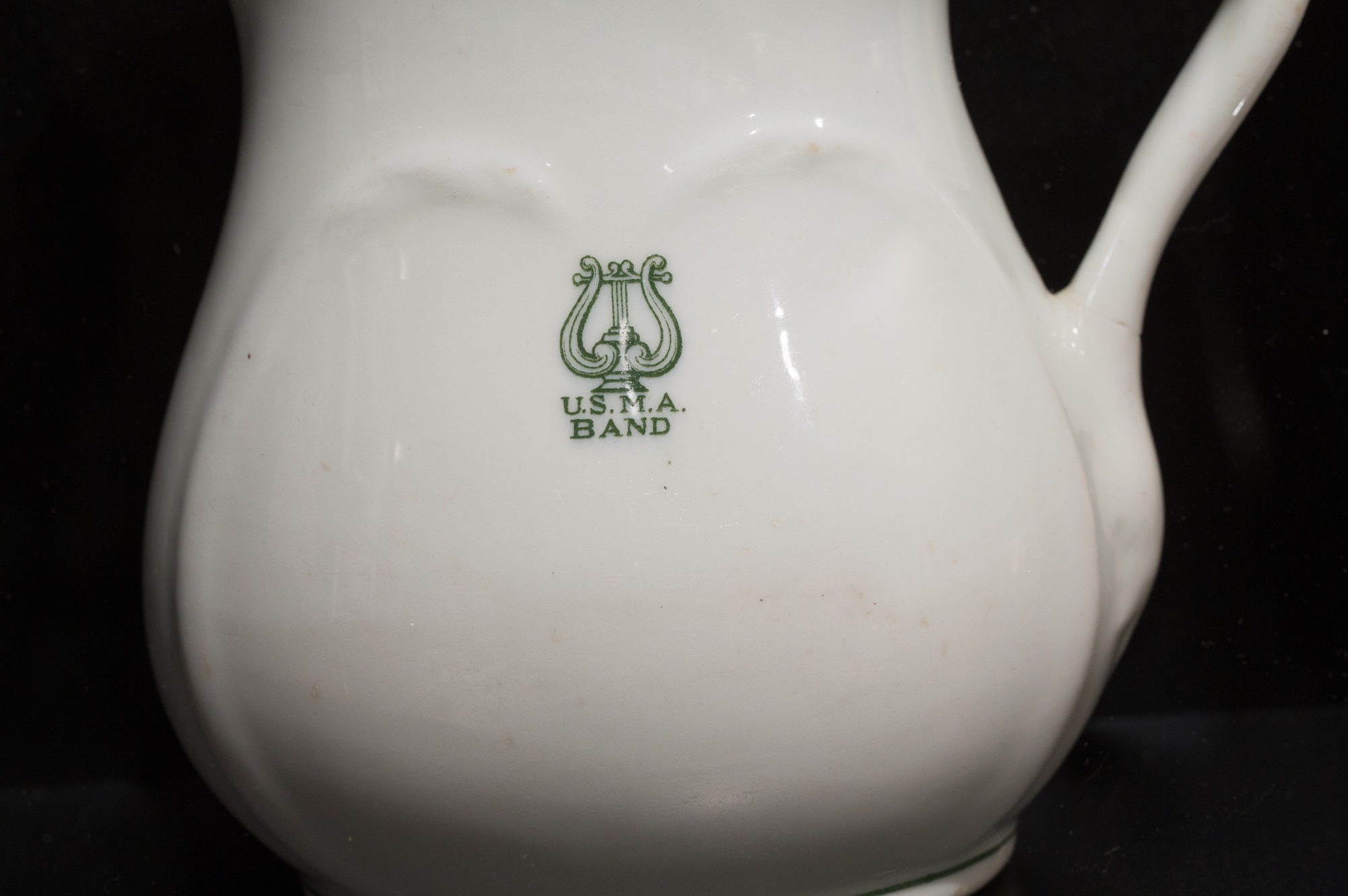
In 1932 a special building was built for the
band. It included rehearsal rooms,
barracks and a mess hall. In January,
1964 the band’s mess hall was awarded Best Mess and Superintendent Lieutenant General
James Lampert brought guests there to dine, preferring the food to that of the
Officers’ Club. Today this building is
named Egner Hall in honor of Philip Egner, Teacher of Music from 1909 to 1934, and
it is still occupied by the USMA Band.
On loan
from the USMA Band
From its very beginning the United States Military Academy Band has represented West Point beyond the banks of the Hudson River. Under Superintendent Sylvanus Thayer the United States Corps of Cadets accompanied by the USMA Band undertook numerous summer marches (or “campaigns” as some cadets called them) as a method of garnering good will towards the Academy. Hugely successful by all accounts, the Corps was greeted by the enthralled citizens of New York City (1816, 1817, 1819), Philadelphia (1820) and, the most famous march, Boston (1821). On July 20, 1821 the Corps boarded steamboats to Troy and from there began the 170 mile march eastward, arriving on August 7th and establishing “Camp Hamilton” on Boston Common. Numerous tours, galas and visitations were held during the two week stay, and the USMA Band figured prominently, even performing for former President John Adams. Euterpeiad reported: “The West Point Band - This Excellent Martial Corps consists of Five Clarinets, Two Flutes, Two Horns, One Bassoon, One Trumpet, One Trombone, One Bugle, One Drum. Mr. Willis, the principal musician and leader, with the Bugle, has given many wonderful specimens of genius and execution, combined with taste and science, in the various military pieces performed by this numerous and well disciplined corps.” It was during this march the Selectmen of Boston presented to the Corps of Cadets what is believed to be its first stand of colors.
For over two hundred years the USMA Band has taken part in similar excursions to such noteworthy events as the Columbian Exposition of 1892, the World’s Fair of 1914, the 1965 Army-Navy Game at Shea Stadium, the 1984 Mirage Bowl in Tokyo, Japan, and in 1991 the AFC Championship Game, televised to millions of viewers worldwide. Now advances in recording and broadcasting brings the USMA Band beyond the reach of tours and live concerts and one can enjoy any number of band performances anywhere at any time.
Begun in 1871, the 100th Night Show celebrates the First Class’s countdown to graduation. The humorous lookback at nearly four years of Cadet-life is largely a musical comedy and is produced with the support of the USMA Band. Over the years many compositions have emerged from the show, the most famous being 100 Days ‘til June written by Francis Resta, Teacher of Music from 1934 to 1957.
The tambourine was found in a locker in Bancroft Hall at the US Naval Academy, undoubtedly “liberated” by a Midshipmen of Annapolis.
Programs on loan from the USMA Band Tambourine WPM#14,512
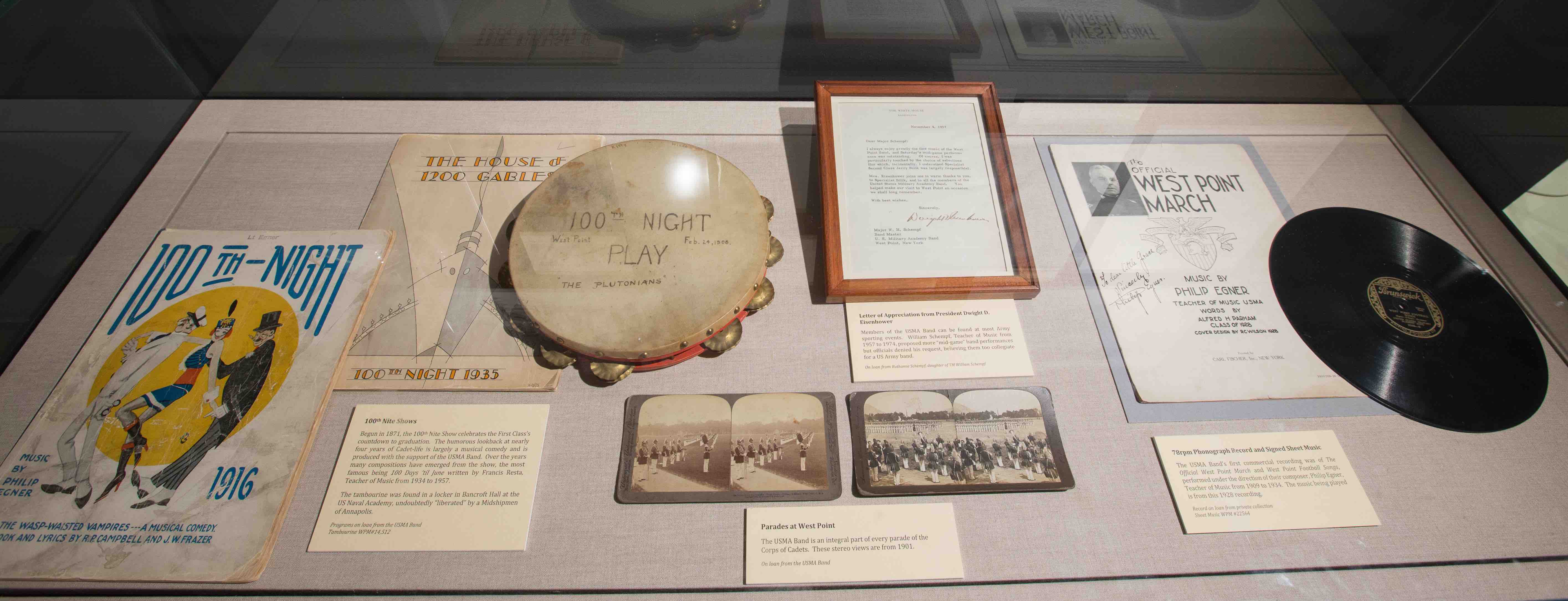
In 1948 the United States Military Academy Band was designated to be one of only three Army Special Bands out of nearly three dozen bands in the US Army. This elevated status also came with increased performance demands and the band’s authorized strength grew accordingly. Originally numbering 14 players at the time of its founding and 43 players during World War II, the USMA Band now grew to 150 players under TM Francis Resta (1934-1957) and reached a high of 174 players in the early 1970’s under TM William Schempf (1957-1974). After the Vietnam War draw downs in the military also called for reductions in the USMA Band to include the loss of the Teacher of Music position, and by 1974 the band’s authorized strength was reduced to 96 players. Similarly, in 2001 further reductions in force resulted in the USMA Band’s current authorization of 79 players and support staff. Despite this ebb and flow of personnel, the United States Military Academy Band has always maintained the highest performance standards.
During the early years low pay rates for bandsmen were not comparable with that of other US Army specialized services. With the prospects of more lucrative opportunities elsewhere, the retention of talented band members was a constant problem until TM Philip Egner (1909-1934) successfully petitioned for increases in pay which probably more than any other factor brought the USMA Band to a truly professional level. Today a rigorous audition process combined with a commitment to the United States Army ensures that the USMA Band accepts only the most dedicated career musicians. Attracting the most talented players would in turn attract the most accomplished composers, and from the 1940’s through the Academy’s 2002 bicentennial celebration some of the country’s foremost composers collaborated with the USMA Band.
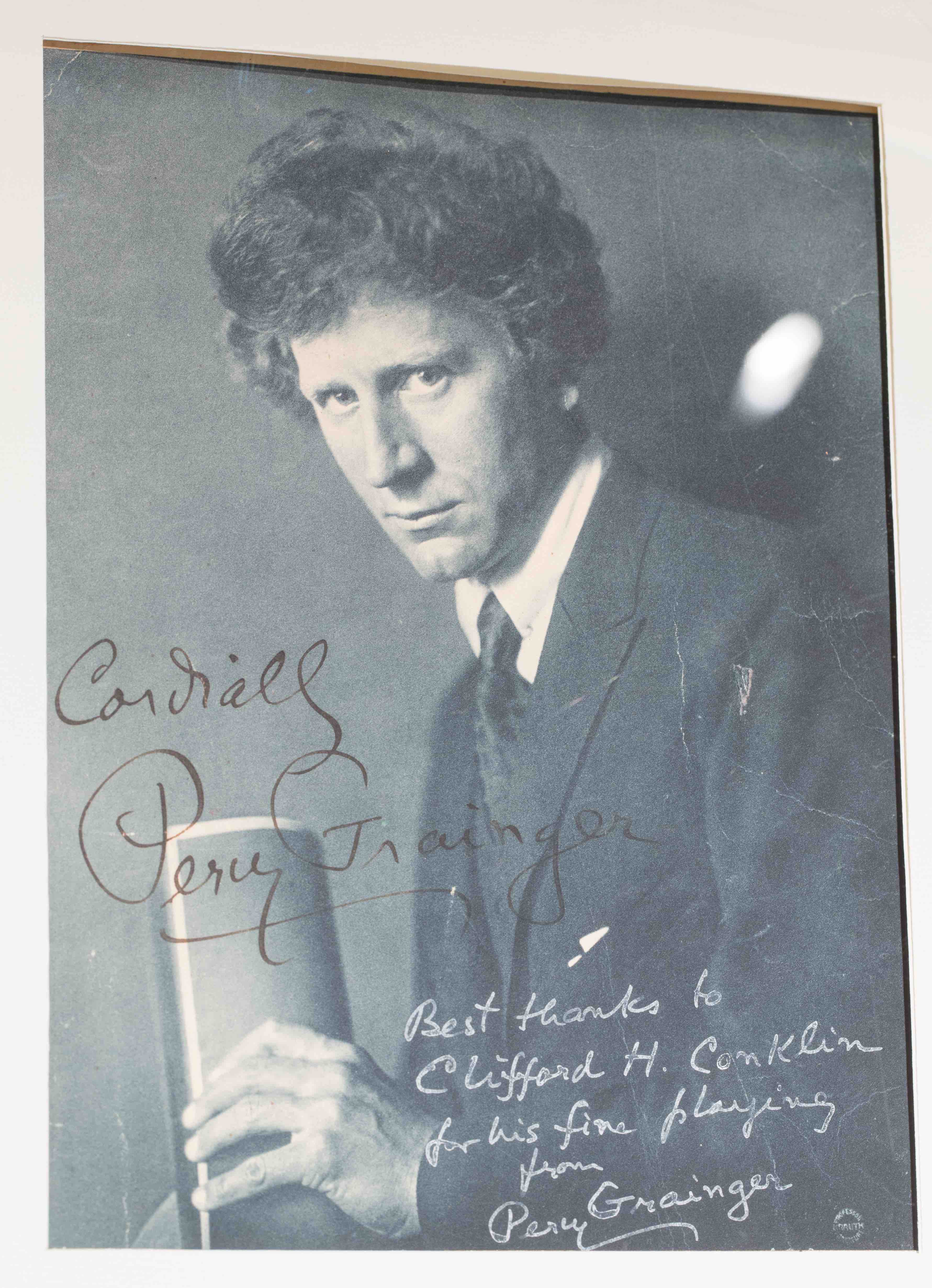
Percy Grainger began an association with the USMA Band in 1940 while living in Westchester County. This collaboration would continue until Grainger’s death in 1961. Grainger was born in Australia in 1882 and after studying in Europe he moved to the United States in 1914. He served as a bandsman in the United States Army during World War One, and became a US citizen in 1918. Following the war Grainger toured the United States performing to huge crowds, mostly on piano.
Grainger was a prolific writer of experimental
compositions and access to an orchestral band was essential to the creative
process. This need was in part fulfilled
by the USMA Band under TM Francis Resta (1934-1957). Resta was a former US Army
bandmate of Grainger’s and the two maintained a longstanding professional
relationship. In appreciation of the
USMA Band’s collaboration Percy Grainger refused payment for his concert
performances at West Point, but once asked for and received a pair of white
uniform trousers and combat boots.
Grainger associated
items on loan from the USMA Band
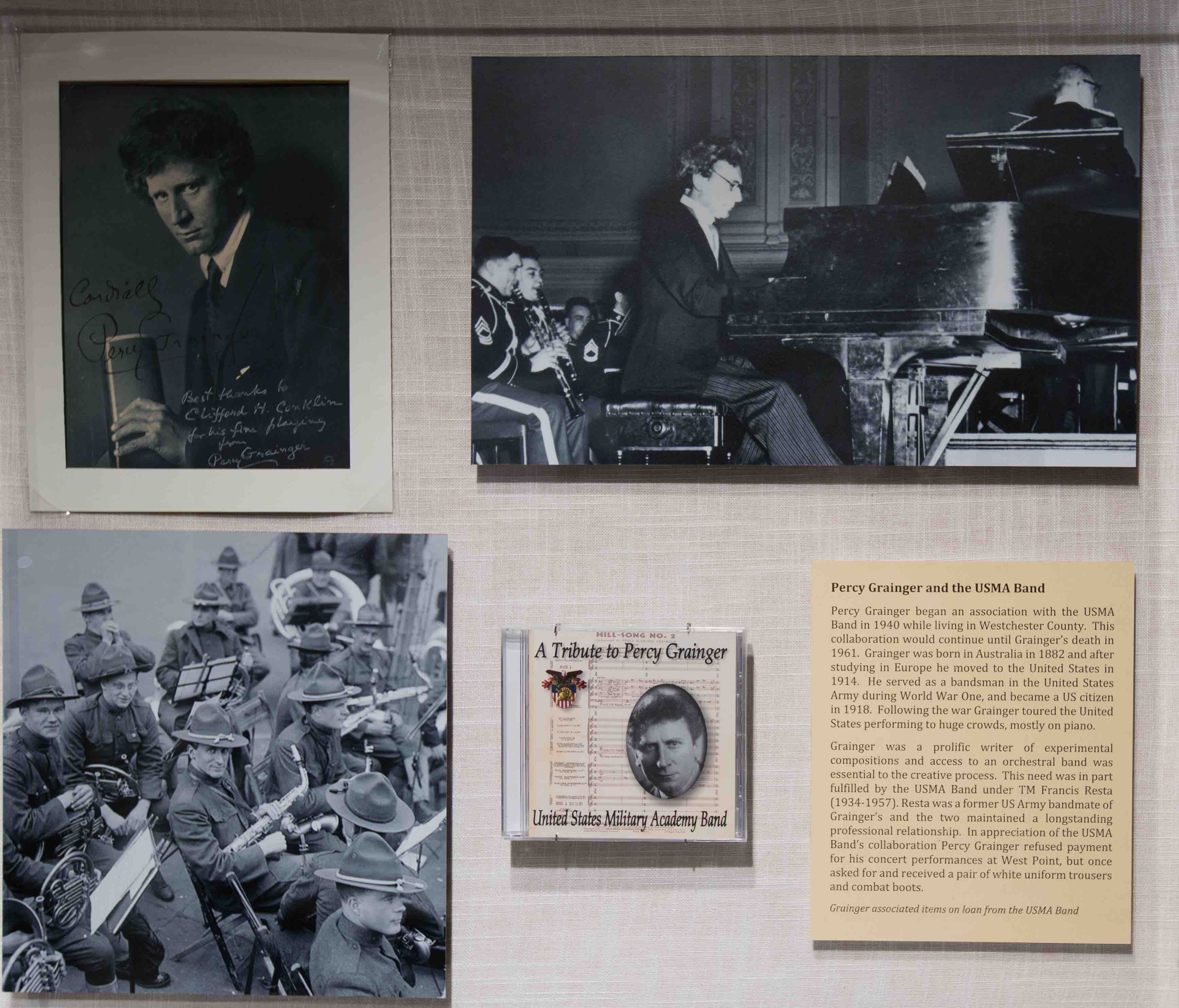
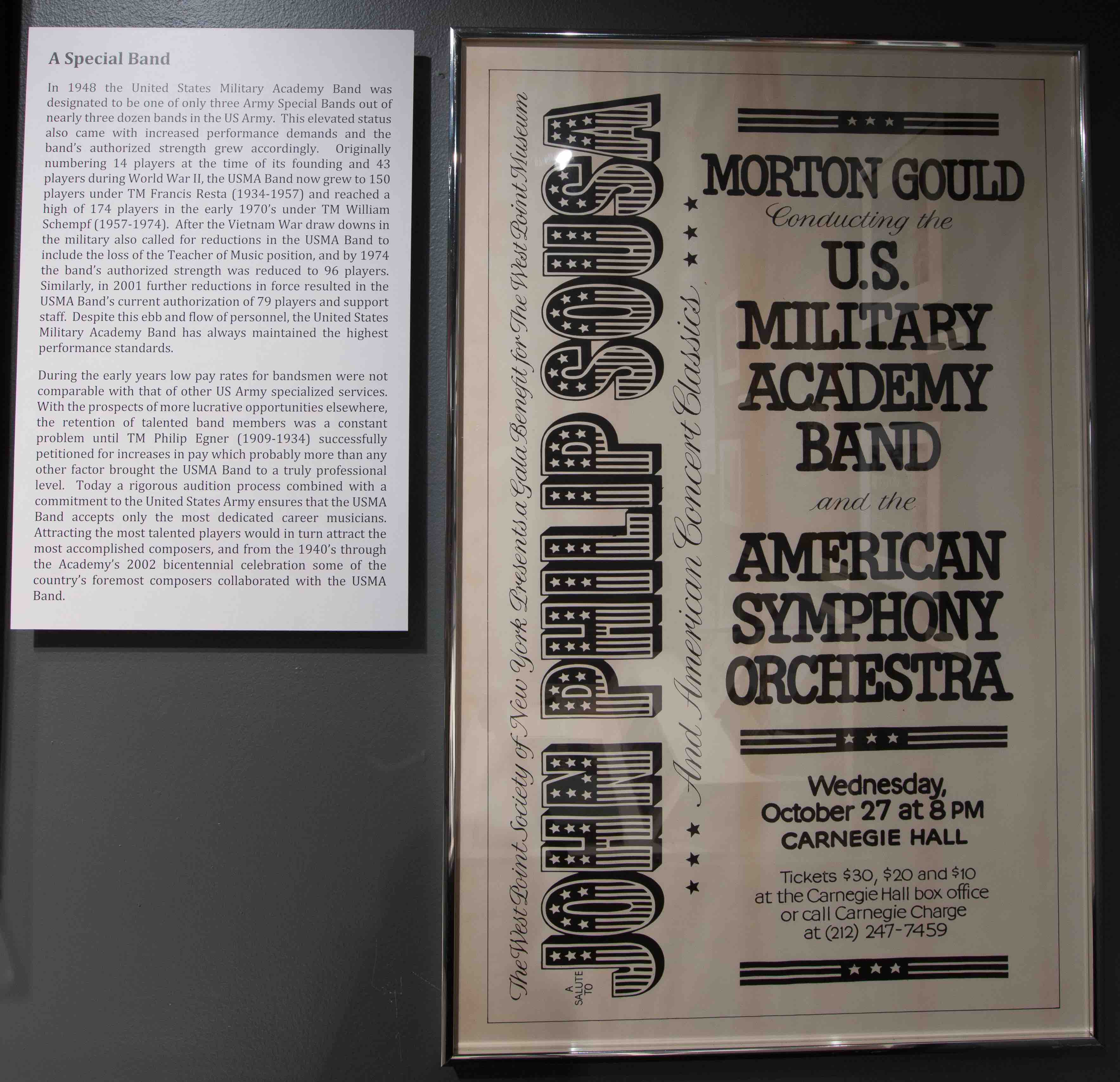
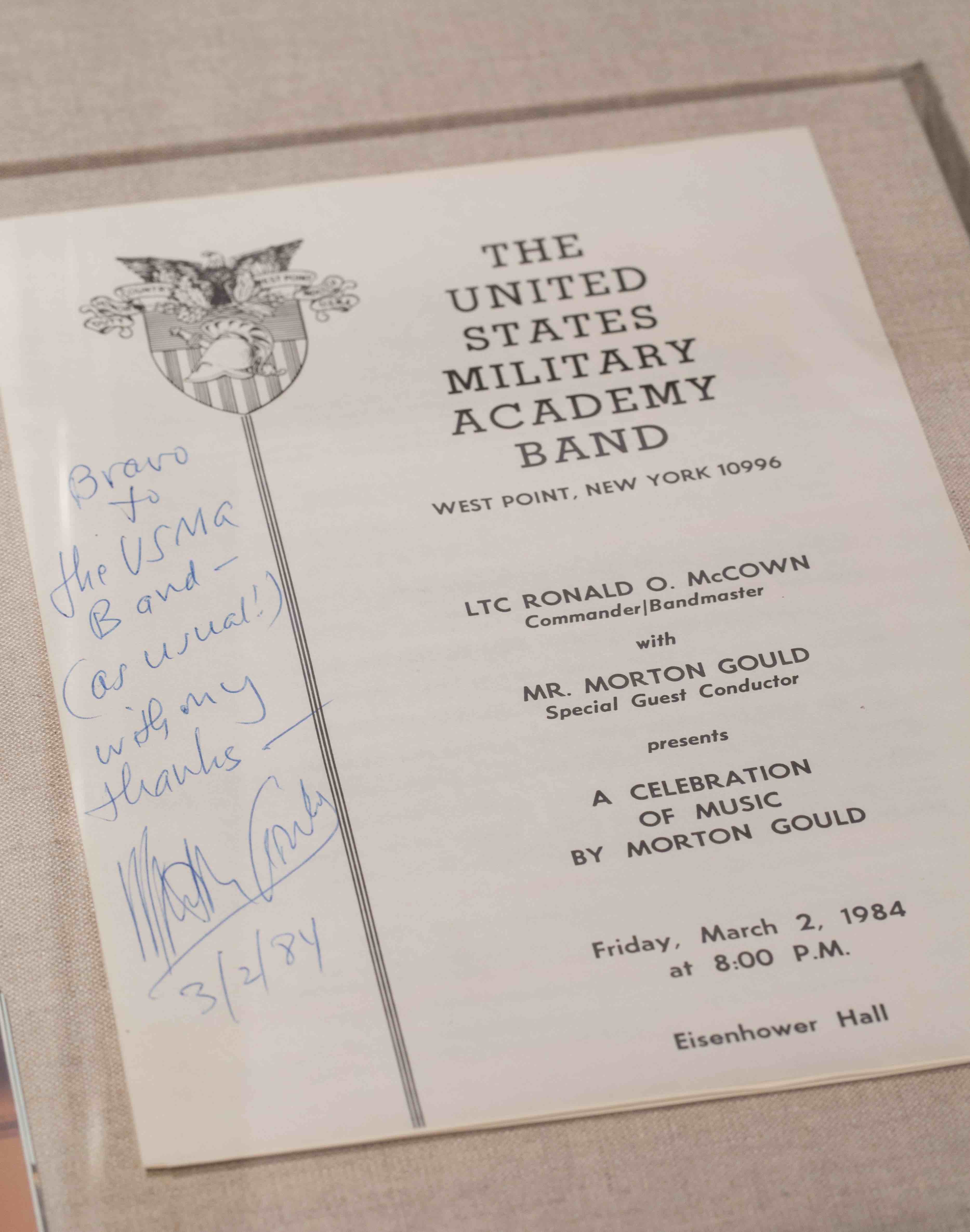
Morton Gould was a child prodigy and by his early twenties he was composing and conducting for national broadcast audiences. Gould began his association with the USMA Band in 1952 when he was commissioned to compose a piece of music as part of the United States Military Academy’s sesquicentennial celebration. That composition became Symphony for Band and was debuted at Carnegie Hall by the USMA Band with Gould conducting.
In 1982 Gould again conducted the USMA Band during a Carnegie Hall benefit concert for the West Point Museum. There he described his inspiration for Symphony for Band:
“I had a vision of all these poor cadets in their daily drills, formations, classes, field training—eating, drinking, and sleeping this army life—the hundreds of parades and reviews before the public. It’s Saturday morning and the Corps is preparing for yet another ceremony. The band is assembling at the barracks. Cadets are running around, getting dressed, inspecting each other, shouting commands, forming up, bumping into each other, and marching faster and faster until everything ends in a blur of motion. A lone cadet finally wakes up with a start from this kaleidoscope nightmare, only to find that it really is Saturday morning and he must now prepare for a review!”
Morton Gould passed away the evening of February
21, 1996, the night before he was to conduct the USMA Band at Disneyland. His last performance was with the band during
that evening’s rehearsal.
Gould associated items
on loan from the USMA Band
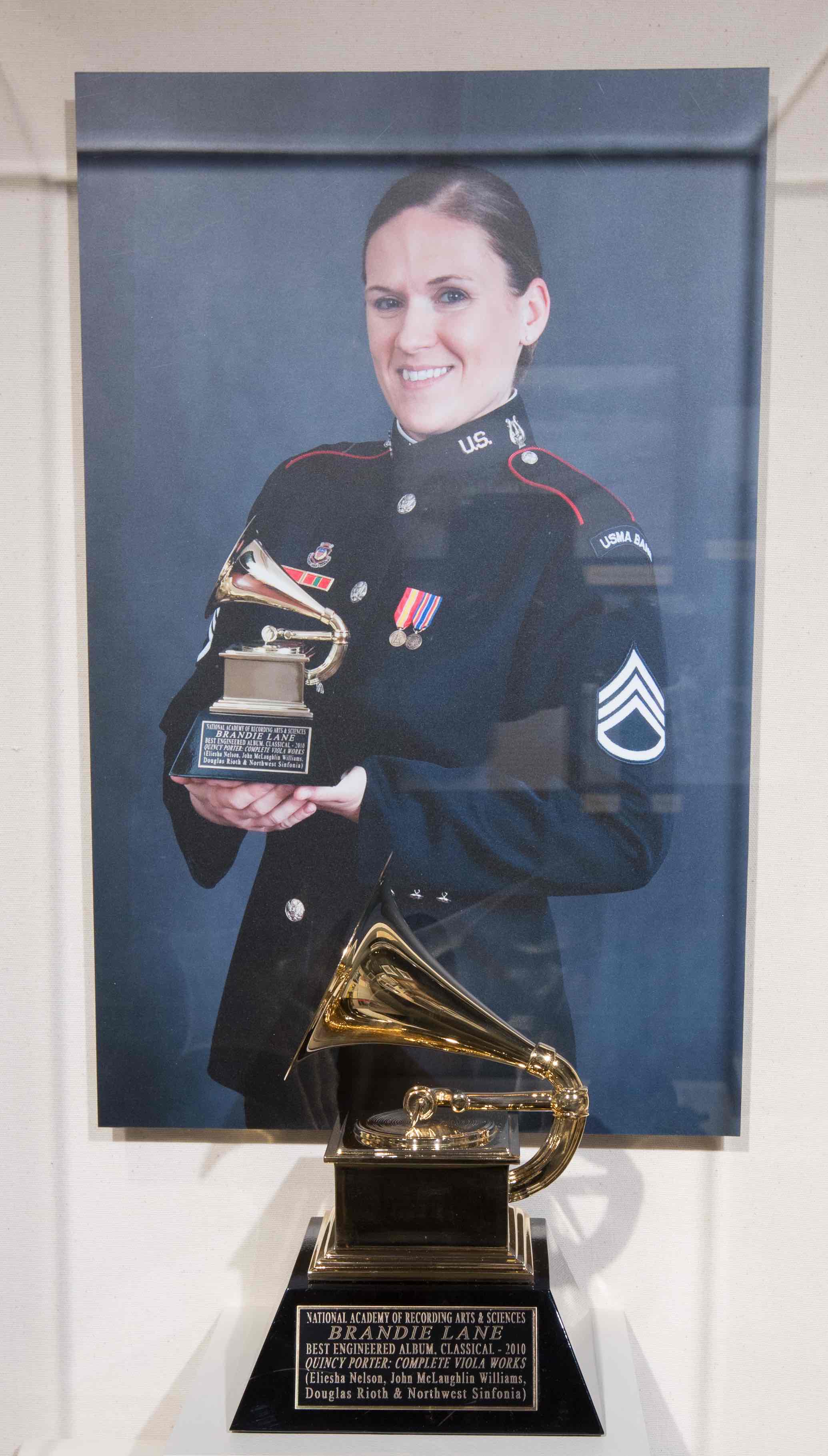
This Grammy Award for Best Engineered Album in a classical category was awarded to USMA Band audio engineer Staff Sergeant Brandie Lane. Staff Sergeant Lane represents the caliber of artists that comprise the band. Only applicants presenting the highest credentials are intensively screened prior to being invited to undergo the very rigorous interview and audition process. If recommended to become a member of the USMA Band the candidate must then fulfill all of the requirements and commitments of enlistment in the United States Army before acceptance. Applicants come from some of the nation’s most respected music conservatories to apply their talents in the service of the United States Military Academy Band.
The United States Military Academy Band holds the unique honor of being the only band of the United States authorized by public law. For 200 years the USMA Band has provided musical support in times of celebration and solemnity for the West Point community and the Nation. Immediately following its official founding in 1817 the band performed for President James Monroe during the first Presidential visit to West Point and it has since then performed for almost every American President including marching in over two dozen Inauguration Parades. The band has also played for many world leaders visiting the United States such as Queen Elizabeth II of England in 1957 and a United Nations gathering of 55 heads of state hosted by President Ronald Reagan in 1985. In 1995 the USMA Band was on hand during President Bill Clinton’s greeting of Pope John Paul II upon the Pontiff’s arrival in New York.
The United States Military Academy Band has also provided dignity and inspiration during times of National crisis. In 1946 the USMA Band was awarded the Meritorious Unit Citation for its support of war efforts during the Second World War, and thirty-three years later it stood on the tarmac of Stewart Air Field as 52 Americans returned from 444 days of captivity in Iran. Finally, the United States Military Academy Band has been present in times of sorrow to render graveside honors for America’s loss.
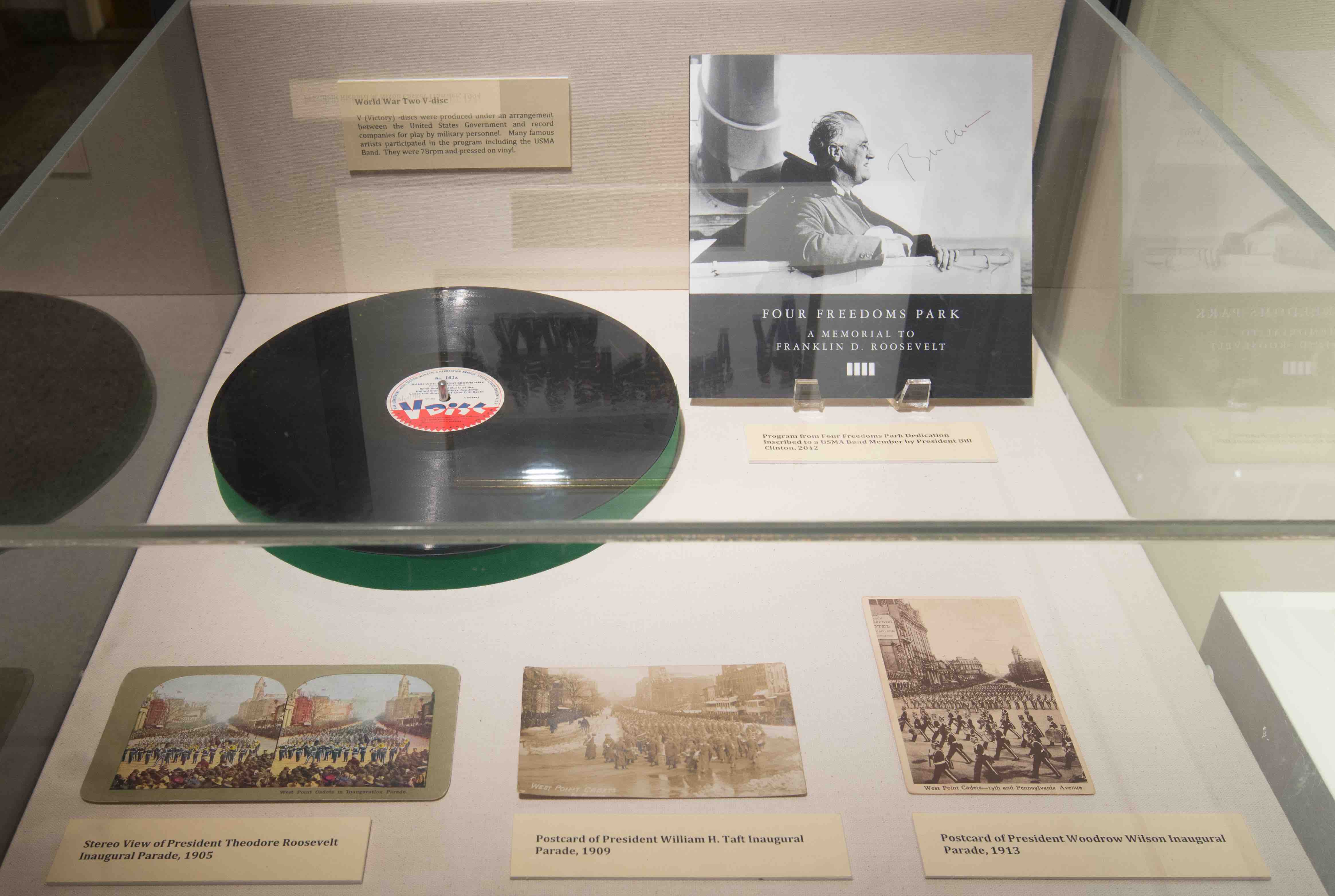
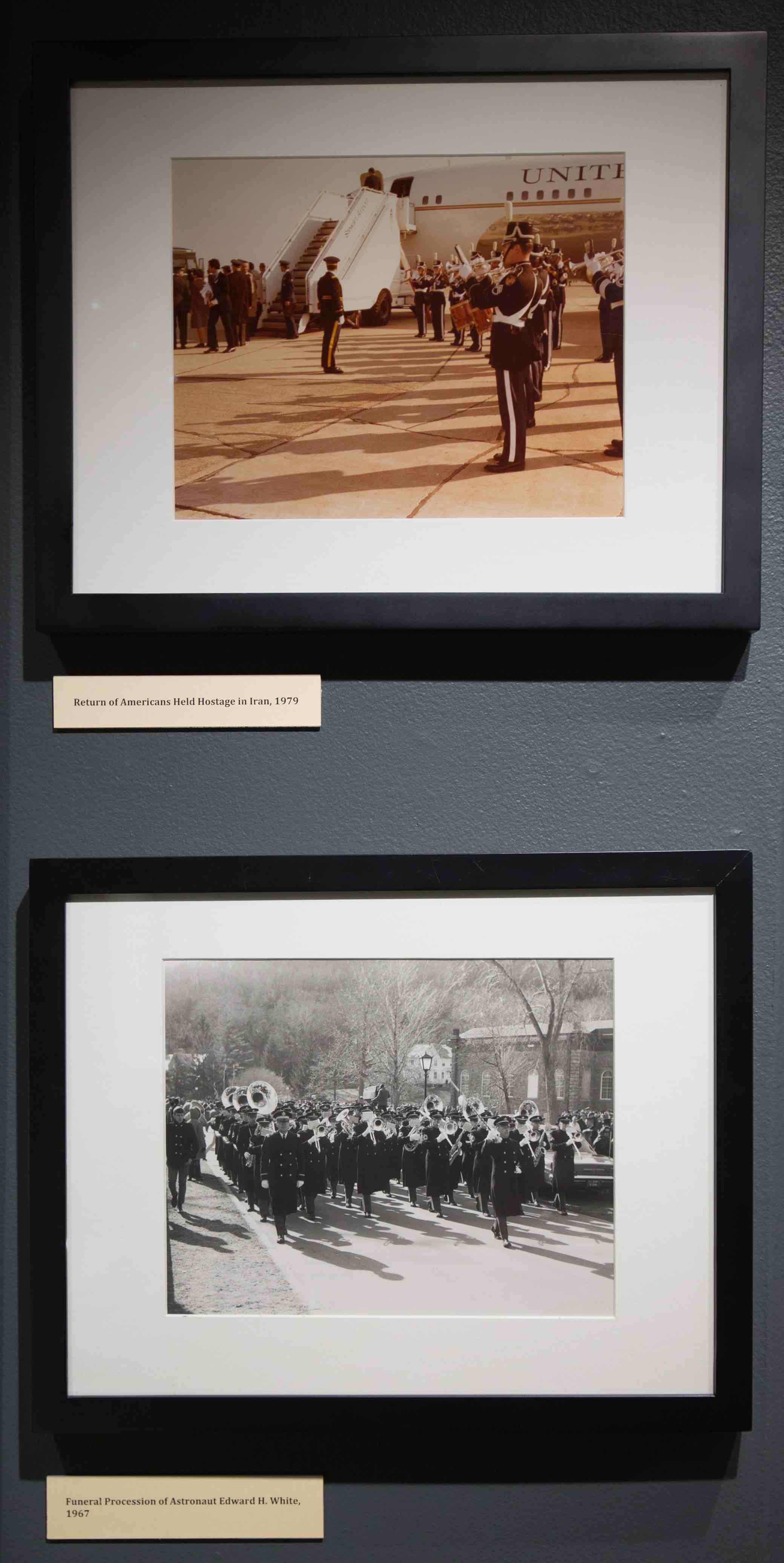
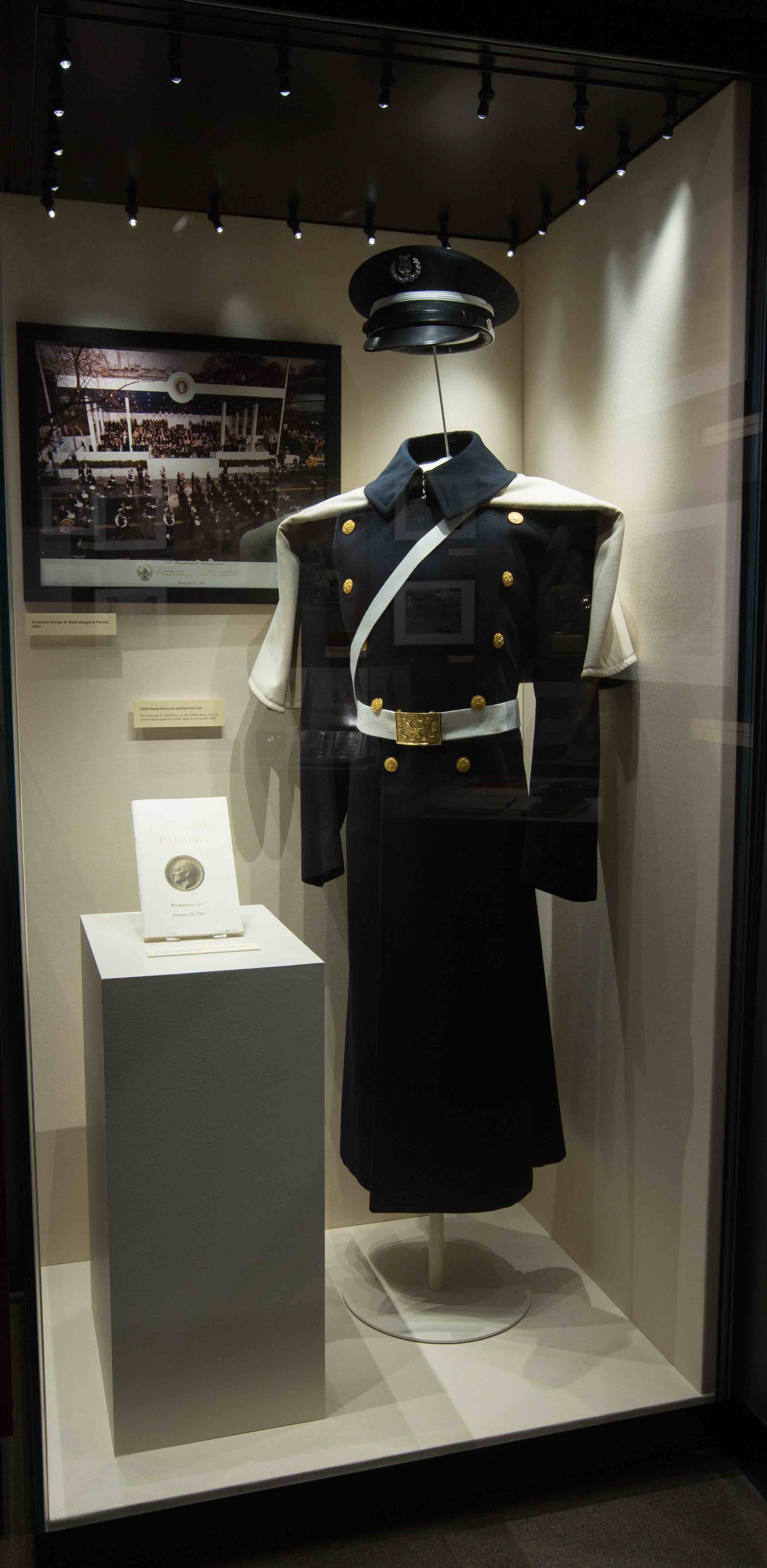
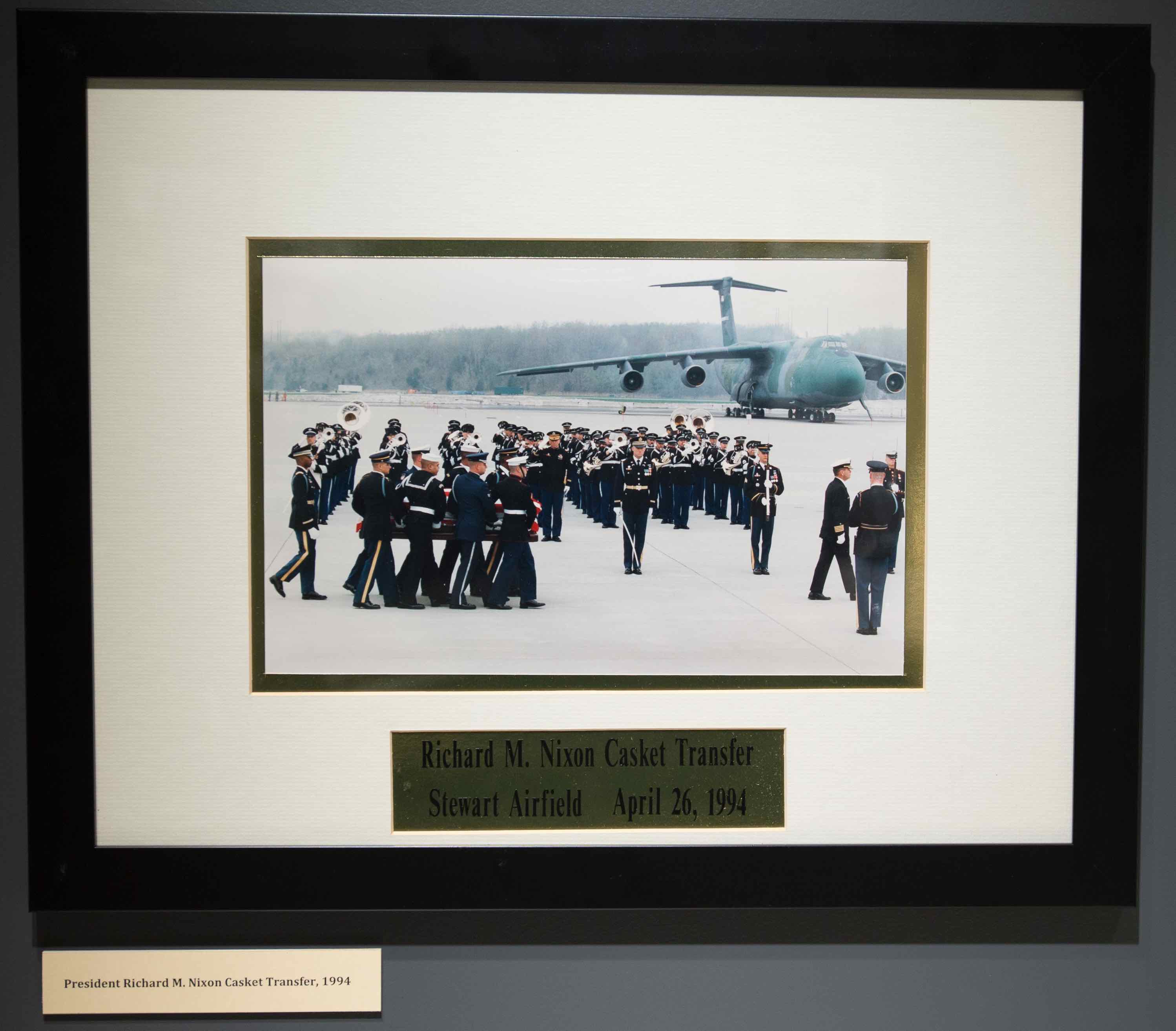
To see all of this and much more, please visit the full exhibit at the West Point Museum. For directions and hours of operation, please click here.